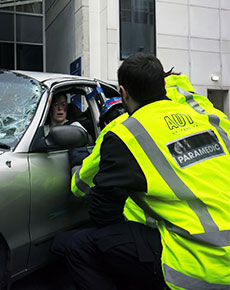AUT crash simulation stops traffic

Paramedicine students from AUT South Campus were put through their paces during a lifelike crash simulation in Auckland Central on August 27.
St Paul Street was transformed into the scene of a two-vehicle pileup, with ‘injured victims’ freed by the Jaws of Life for AUT LIVE – the university’s open day.
A team of six paramedicine students took part in the multi-service emergency response, carried out in line with international best practice.
They were given the challenge of responding to head injuries, a chest trauma, leg fracture, back pain and intoxication as hundreds gathered to watch.
“Simulated crashes like this enhance our training and help prepare students for clinical placement and real-world emergencies,” says Luke Summers, Programme Leader, Paramedicine at AUT South Campus.
Few people are prepared for the sheer noise and confusion of a real crash scene, with multiple services and appliances moving in, and generators running.
The exercise tests complex decision-making, problem solving, clinical knowledge, communication and teamwork – under pressure.
Two crews from the New Zealand Fire Service also participated in the scenario.
“Students get to experience how emergency services integrate in time-critical situations in order to improve patient outcomes,” says Summers.
Another six paramedicine students went through hours of wardrobe and make-up to act as crash victims, which provides them with an insight into what the patient experiences.
Paramedicine students perform 1,000 hours of clinical placement.
AUT South Campus is the only university in New Zealand that offers a Bachelor of Health Science (BHSc) in Paramedicine. It is also internationally accredited, making graduates sought after all over the world.
Graduates become paramedics in land and air ambulance services, hospitals, industry sites and the defence force. They are also employed in emergency management and international relief work.